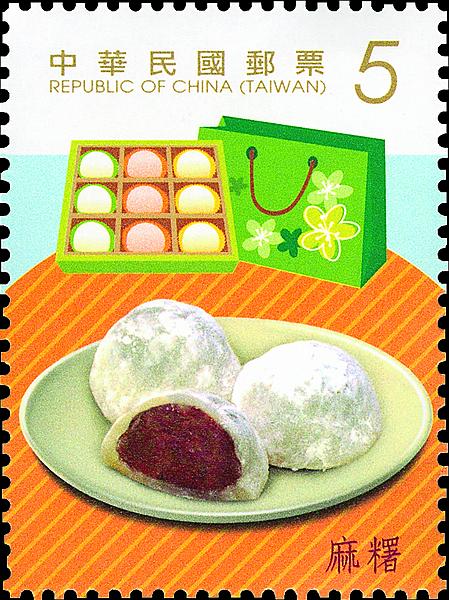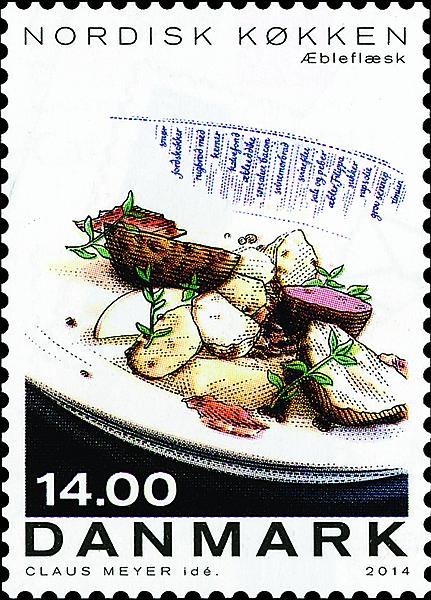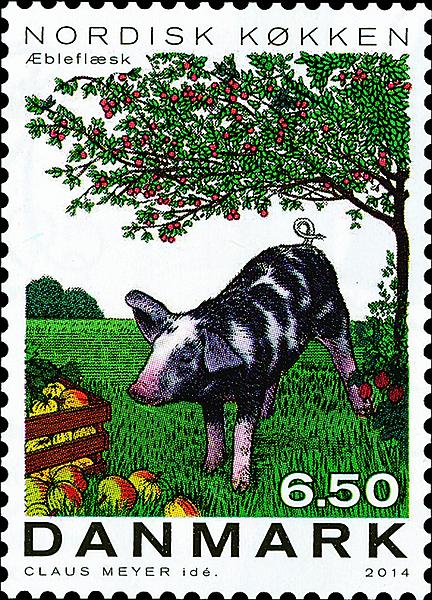World Stamps
Food on stamps: pork and apples, waffles, gift desserts
Two Scandinavian food specialties are displayed on new stamps from Denmark and Norway.
Denmark’s post office, Post Danmark, issued two Nordic Cuisine stamps Jan. 2 featuring aebleflaesk. The 6.50-krone stamp, shown on the left in Figure 1, pictures a pig and an apple tree, representing the main ingredients of aebleflaesk.
The prepared dish is depicted on the 14kr stamp, shown on the right in Figure 1.
The stamp designs are based on an idea from Claus Meyer, chef, entrepreneur and promoter of the new Nordic cuisine.
The principles behind this cuisine are “ecology, sustainability and high-quality local produce,” according to Post Danmark.
Post Danmark adds, “In short, new Nordic cuisine is renewing our old traditionals in a radical way.”
For the new stamps, Meyer has reinterpreted aebleflaesk, a traditional dish that dates back more than 250 years.
Bo Frederiksen, a chef and culinary advisor at Meyer’s Food House in Copenhagen, told Post Danmark, “Aebleflaesk is a dish with great qualities, but also a simple dish that was easily updated to include in the narrative about new Nordic cuisine. The new version is lighter, more beautiful, juicier and more aromatic than its predecessor.”
Post Danmark has printed Meyer’s recipe on a product it calls a “first-day sheet.” A first-day cover is attached to the back of the sheet.
The recipe also is available in Danish on the website www.postdanmark.dkfilateli.
The self-adhesive Nordic Cuisine stamps were printed by offset in booklets of 10.
Norway
A heart-shaped waffle is pictured on a commemorative stamp marking the 150th anniversary of the Norwegian Church Abroad. Figure 2 shows this 15-krone stamp issued Jan. 2 by Norway Post.
The Norwegian Church Abroad, also known as Sjomannskirken or the Norwegian Seamen’s Church, was founded by Johan Cordt Harmens Storjohann Aug. 31, 1864, to secure the moral and religious education of Scandinavian seamen in foreign ports and also to provide a cultural and social meeting place.
The Norwegian Church Abroad reports that today “it serves around 900,000 Norwegians annually through over 30 churches and 15 chaplains traveling to more than 80 countries around the world visiting Norwegians around the globe.”
The stamp was unveiled at St. Olav’s, the Seaman’s Church in London, England.
According to a press release on the mission’s Norwegian-language website, it is the first Norwegian stamp issued in a church and in a foreign country.
The release also mentions that waffles, or vaffles as they are known in Norway, were served during the ceremony.
Norway Post explained that the waffle design was selected for the stamp because the “heart shape symbolizes the care that the church represents.”
In addition to showing the waffle, the design includes a stripe from the Norwegian flag at the top.
Stian Hole designed the stamp. Joh. Enschede of the Netherlands printed it by offset in coils of 100. The quantity printed of this self-adhesive stamp was 15,090,000.
At least two countries have issued stamps specifically honoring waffles.
Another heart-shaped waffle is pictured on the coil stamp in the 2010 Swedish Foods set (Scott 2643), and Belgium includes its version of the waffle on a cuisine-themed sheet in a series called This is Belgium.
The pane of 10 stamps showing the Belgian waffle and other Belgian food and beverages was issued Nov. 19, 2006 (2177).
Taiwan
Also in January, Taiwan highlighted its cuisine on stamps in its Signature Taiwan Delicacies series.
The series began in 2013 with stamps picturing home-cooked dishes and gourmet snacks.
The new set of four se-tenant (side-by-side) NT$5 stamps issued Jan. 22 features desserts that are sold in gift packages.
Taiwan’s Chunghwa Post calls this set Gift Desserts from the Heart.
The stamp shown in Figure 3 pictures a plate of mochis in the foreground and the gift box and bag iwith a floral design in the background.
Chunghwa Post describes mochi, a dessert made of glutinous rice, as “savory and chewy.” Mochi is prepared both filled and unfilled.
The other three stamps in the set show the following desserts along with their gift packaging: pineapple shortcrust pastries, sun cakes, and egg yolk pastries or cakes.
The firm Up Creative Design and Advertising Corporation designed the stamps.
Cardon Enterprise Co. printed them by offset in sheets of 16.
Cyprus
Cyprus issued stamps Jan. 30 honoring the olive tree and its products.
Cyprus has a long history of producing oil products. According to the About Cyprus website, www.aboutcyprus.org.cy, maintained by the Press and Information Office of the Republic of Cyprus, olive trees have grown on the island since at least the Neolithic period (sixth millennium B.C.) and have been cultivated since the second millennium B.C.
Ancient oil presses for the production of olive oil dating back to the end of the 13th century B.C. have been discovered on Cyprus.
The Olive Tree and Its Products issue includes three stamps: a €0.34 denomination picturing an olive tree in the foreground and rolling hills covered with more trees in the background; and a pair of se-tenant €0.51 stamps showing ripe olives and a bottle of olive oil.
Marianna Iacovou designed the stamps. Giesecke & Devrient Matsoukis printed them by offset in sheets of eight. The quantities printed were 550,000 of the €0.34 and 137,5000 pairs of the €0.51 stamps.
MORE RELATED ARTICLES
Headlines
-
US Stamps
Oct 7, 2024, 3 PMMcMurtrie dismissed as APS education director following Sept. 21 arrest
-
US Stamps
Oct 7, 2024, 12 PMVasiliauskas named president of Mystic Stamp Co.
-
US Stamps
Oct 6, 2024, 5 PMApgar souvenir card available
-
US Stamps
Oct 6, 2024, 4 PMFirst Continental Congress and U.N. stamps receive Scott catalog numbers









